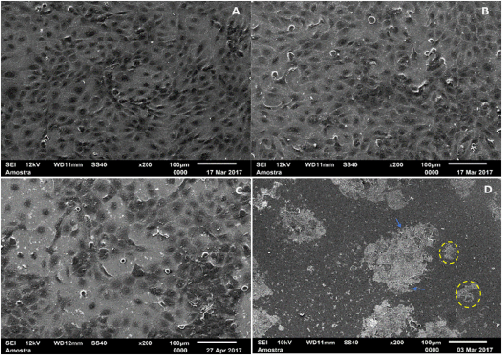
Abstract: The number of studies on microcrystals containing silver has increased in recent decades. Among the silver-containing microcrystals, alpha-AgVO3 has gained prominence owing to its polymorphism that allows it to exert interesting antimicrobial activity against pathogenic microorganisms. The aim of this study was to evaluate the antifungal activity and cytotoxicity of three different alpha-AgVO3 microcrystals when in solution. alpha-AgVO3 microcrystals were synthesized using the co-precipitation method at three different temperatures (10 degrees C, 20 degrees C, and 30 degrees C), and then characterized by X-ray diffraction and scanning electron microscopy. The antifungal activity of alpha-AgVO3 microcrystals against Candida albicans was determined by estimating the minimum inhibitory concentration (MIC) and minimum fungicidal concentration (MFC). Fluorescence images were obtained to confirm antifungal concentrations. To assess the biocompatibility of microcrystals applied at MIC and MFC on keratinocytes cells (NOK-si), an Alamar Blue assay, scanning electron microscopy, and a DNA gel integrity test were carried out. The quantitative and qualitative results showed that, regardless of the co-precipitation method used to synthetize alpha-AgVO3 microcrystals, C. albicans growth was visibly inhibited at 3.9 mu g/mL (MIC) and completely inhibited at 15.62 mu g/mL (MFC). The cytotoxic and genotoxic outcomes revealed that the MIC and MFC concentrations did not affect NOK-si cell morphology, proliferation, or DNA integrity. The search for new antimicrobial materials has been the focus of the research community recently because of increases in microbial resistance. The findings reported herein demonstrate a novel antifungal and non-cytotoxic material that could be used in biomedical and dental applications.
Author(s): Pimentel, BNAD; de Foggi, CC; Barbugli, PA; de Oliveira, RC; de Avila, ED; Longo, E; Vergani, CE
MATERIALS SCIENCE & ENGINEERING C-MATERIALS FOR BIOLOGICAL APPLICATIONS
Volume: 108 Published: MAR 2020
DOI: 10.1016/j.msec.2019.110405




